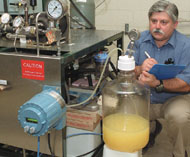By Ed Hunter
 A new process that uses carbon dioxide gas under high pressure can
produce orange juice that tastes just like fresh-squeezed, but is as safe
to drink as the heat-pasteurized variety, according to a University of
Florida food engineer who helped perfect the process.
A new process that uses carbon dioxide gas under high pressure can
produce orange juice that tastes just like fresh-squeezed, but is as safe
to drink as the heat-pasteurized variety, according to a University of
Florida food engineer who helped perfect the process.
Murat Balaban, a professor with UF’s Institute of Food and Agricultural Sciences, said the process produces juice that has proven indistinguishable in taste tests from fresh-squeezed juice.
“We have done extensive taste tests where people cannot tell the difference between fresh-squeezed orange juice and orange juice that is made safe and long lasting with this process,” Balaban said. “There is no taste difference between that and the fresh-squeezed orange juice.”
In the new continuous process, fresh-squeezed orange juice is mixed with pressurized carbon dioxide and passed through a tube. At the end of the process, the juice is depressurized and separated from the gas, killing harmful microorganisms.
“We have done extensive experiments with harmful organisms, and we have shown that we can substantially reduce the number of those organisms,” Balaban said. “We tested for E-coli, salmonella and other organisms.
 “In all of those cases we have shown that we can reduce the number of organisms
to levels that meet current Food and Drug Administration standards,” he
said.
“In all of those cases we have shown that we can reduce the number of organisms
to levels that meet current Food and Drug Administration standards,” he
said.
Balaban said most orange juice sold in stores is heat-pasteurized to kill bacteria and microorganisms that can get into the juice at several stages during the production process. He said the heat process is effective but has a negative effect on the quality of the juice.
“The heat pasteurization not only kills microorganisms but also changes the flavor of the juice,” Balaban said. “The juice acquires a slightly cooked flavor.”
Balaban said the new process has another benefit: It inactivates an
enzyme that causes orange juice to separate when it sits on a shelf. “When
the juice separates, you get a water-like transparent liquid at the top
and a gooey, yellowy mass at the bottom,” he said.
“And if you shake the juice, it still separates in a very short time
and that’s not appealing to the consumer.”
The new process also better preserves vitamins, especially vitamin
C, he said, and provides the juice with a shelf life similar to that of
heat-pasteurized juice.
“The shelf life of fresh-squeezed orange juice under the best of circumstances is about 14 days,” Balaban said. “The shelf life of thermally processed, heat-pasteurized orange juice is about two months, and the shelf life of orange juice processed using this new technology will also be about two months.”
Balaban has been testing the continuous process on a small scale using equipment developed by Praxair, a major supplier of industrial gases, including the carbon dioxide used in this process. He said UF has patented the process and has granted Praxair an exclusive license to commercialize it.
In addition to orange juice, Balaban said some preliminary testing has been done on apple and pineapple juice with good results.
Murat Balaban mob@gnv.ifas.ufl.edu